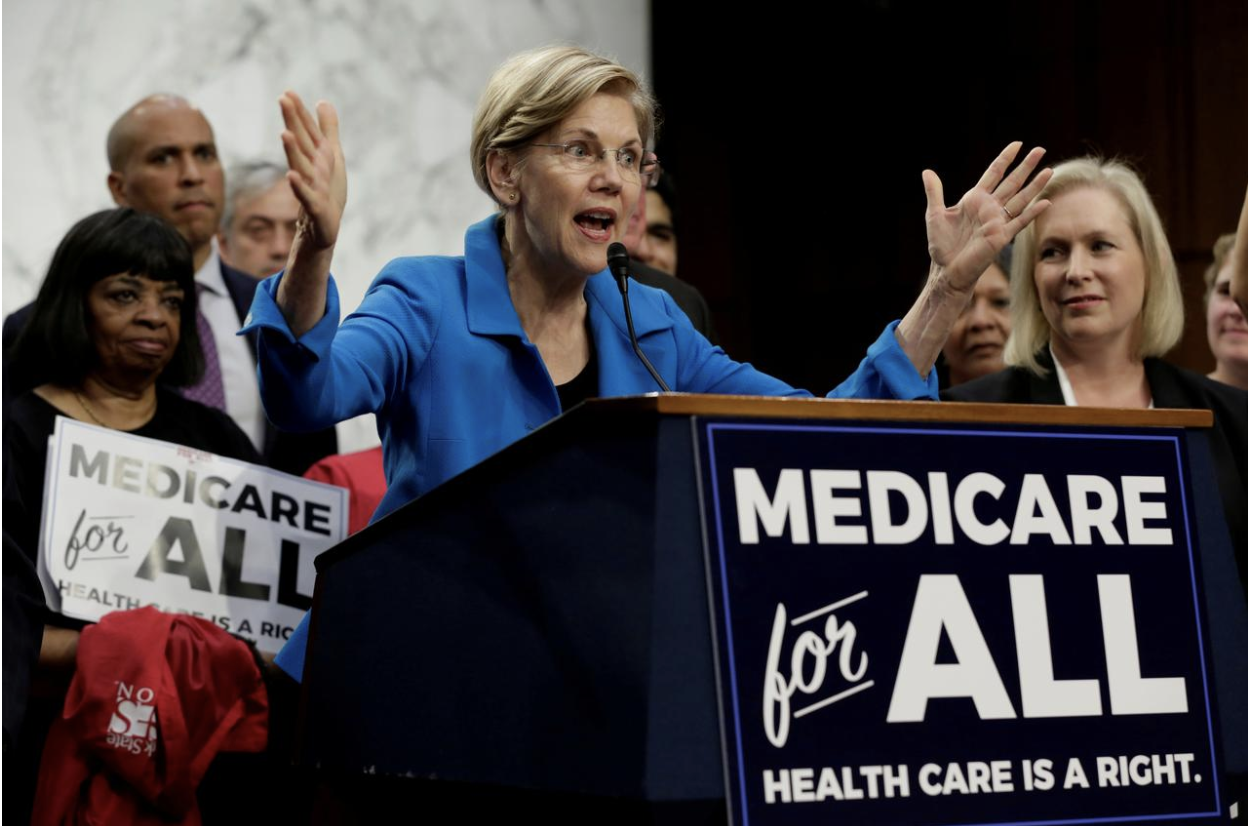
KONNOR VON EMSTER – DECEMBER 5TH, 2019 EDITOR: ANDY BABSON
You would be hard-pressed to find someone who is happy with the state of the US healthcare system. Americans are justifiably disappointed that our country is failing us in this regard. 87 million are underinsured. 37 million skimp on prescriptions due to costs. 57 million have trouble covering their medical bills. All of these are facts and figures mentioned by Elizabeth Warren in her grand single-payer plan: “Ending The Stranglehold Of Health Care Costs On American Families.” This is in response to the repeated healthcare reform failures of the last century. A minor achievement was made when Congress passed the Affordable Care Act (ACA), although two of its three main components, the individual mandate tax penalty and independent payment advisory board, have since been gutted, rendering it useless in countering rising healthcare costs and insurance premiums.
As the US enters election season, Democratic primary candidates are offering up solutions for our failing healthcare system including such ideas as single-payer, which is all too familiar among Europhiles. Elizabeth Warren’s proposal is similar to Bernie Sanders’ “Medicare For All” and outlines her comprehensive summary in three main components: cutting costs in healthcare provision, tax increases, and changes in discretionary spending. Below are all the details along with an economic analysis.
Cutting Costs in Healthcare Provision
Healthcare cost inflation has been one of the largest contributors to the rising cost of Medicare. To curtail this inflation, Warren’s plan seeks to implement payment reform for hospitals and physicians. By reducing administrative costs through the elimination of health insurance, Warren expects to cut spending by $350 billion. Warren projects that administrative spending for hospitals will decrease as well, with increased standardization of medical treatments across the entire US. To address the healthcare cost variations from state to state, Warren also plans on reimbursing hospitals with a sliding scale of medicare rates to cover the exact costs of care. In this vein, she believes that restoring health care competition through the break-up of big hospital chains will restore lower prices, as firms (hospitals) will have less market power.
Her next cost-cutting measure is slashing drug prices through forced negotiations with drug companies. The government as a whole will be able to bargain with huge companies for lower costs, specifically, for a cost equal to no more than 110% of the international retail price. Of course, lowered prices will reduce R&D spending, which drugs companies’ futures subsist on, but it will also force companies to cut down on dividends, marketing, executive salaries, and the other generous expenditures characteristic of monopolistic industries. When companies are unwilling to negotiate, Warren proposes another solution: public manufacturing. The government will produce generic drugs, and override the patent the company holds. This is a huge departure from patent and copyright laws of the present, and will be one of the largest bargaining tokens for the candidate.
Warren then points out that healthcare expenditure growth is outstripping GDP growth. There are many different reasons for this fact, such as the real growth of the healthcare sector, inflation specific to healthcare, and changes in discretionary expenditure. Whatever the cause, this extreme inflation is cited by Warren as one of the largest problems for financing single-payer healthcare. Thus, she plans on adopting a comprehensive model to calculate the expected cost of medical expenses and pay providers according to these expected costs. By streamlining healthcare across all types of public healthcare spending, including the VA, Medicare, and Medicaid, Warren expects further reductions in administrative costs.
Raising Money To Pay For It
Cutting costs is only a fraction of the battle though, since it is expected to save only $7 trillion of the $27 trillion needed to finance the legislation over the next decade. To raise money, Warren focuses mainly on taxes, targeted mostly at the upper class and large employers. One of her key mantras for single-payer has been not to raise taxes on the middle class, which has set her apart her from opponents. Bernie Sanders, for example, has agreed to middle class tax hikes in order to support the bill. This has put Warren in an extreme bind in financing the bill. Before the plan came out, Warren repeatedly dodged the middle class tax hike question in favor of saying that costs would decrease for the average family.
One of the largest parts of her financing plan is replacing the employer health mandate with an employer Medicare contribution. This would not affect small businesses (<50 people) and would simply change the accounting structure; firms would now pay the same amount to the government as they once did to insurance companies. This is effectively a tax break on small businesses, the differential treatment of which has been the precedent for a long time and, so, would not be too drastic a departure from the present. One benefit of this would be greater professional mobility, as workers would no longer feel tied to their current job based on the quality of their employer’s insurance plan, effectively eliminating a form of labor market friction. One disadvantage is that this approach would typically undermine unions’ power to fight for better healthcare plans and provisions. To remedy this criticism, Warren plans to maintain unions’ power by allowing companies to reduce their contribution if they pass on the savings in the form of increased pensions or salaries.
Tax evasion is another revenue source Warren is looking to capitalize on. While this method has been questioned by many economists, conservative estimates provide support that cracking down on tax evasion could increase revenue by $2 trillion over the next 10 years. This figure is contested; Warren derived this revenue from estimating a tax gap of $770 billion, but the IRS claims the tax gap is closer to $500 billion. Warren points out that the IRS has not scaled its estimate with the economy or population because of many nefarious budget cuts, implying that there is a lot of room for potential revenue generation by cracking down on tax evasion.
To supplement the revenue from the IRS, Warren then proposes a long list of financial taxes that are very uncommon. This includes a “Wall Street tax” of 10 basis points (0.1%) on all financial goods. While Wall Street is opposed to this, arguing that investors will choose to make fewer trades, there may be a silver lining: a decrease in speculation. The tax may improve the stability of the financial system, as discussed in Hyman Minsky’s theory of financial instability, in that it will curb excessive speculation that can cause economic fluctuations. Like any tax, there will be some price distortions, but it must be contrasted with the revenue and utility gained from single-payer healthcare. This trend of using taxes on goods not associated with the use of the product they are funding is furthered in Warren’s large bank fee. In essence, it is a “too big to fail” fee, correcting for the risk posed by companies that are so vital to the US economy that their bankruptcy would cause certain financial crisis (this was the reasoning for bailing out AIG in 2008). Instead of placing this in an insurance type of fund, Warren plans on spending this money to fund the healthcare system, which may cause issues if one of these companies did indeed fail.
Cutting depreciation deductions in taxes and increasing corporate taxes is yet another leg to this complex financing plan. Depreciation deductions on capital help offset the high upfront cost associated with said capital, although Warren says that it is now being used as a tax loophole for large companies and the rich. Her corporate tax policy is very digestible; she suggests taxing company’s profits at the difference between the US and the foreign country rate their profits are realized in. This would be a huge departure from current practice, where companies are constantly required to repatriate their money if it is needed on home soil. However, this would be more in line with a policy the US has already established requiring expats to pay taxes on their foreign income. At the same time, Warren expects to collect taxes on foreign corporations, which will likely act somewhat like a tariff.
Warren’s final measures come down to taxing the wealthy not only on their income, but also on their wealth. The ultra-millionaire wealth tax will charge people who have over $50 million 2% of their wealth per year, and 6% per year for those with over $1 billion. Her reasoning is that these ultra-wealthy people have special investment opportunities that are unavailable to most citizens. Her proposal also includes raising the capital gains tax rate to that of the income tax, but then splits from orthodoxy by proposing to tax capital gains annually instead of when it is realized. If an asset increases in value, the owner would have to pay capital gains on that asset the same year. If it decreases in value, then the owner would offset some amount of the taxes, which would act very similarly to the depreciation deductions Warren wanted to eliminate to raise more taxes. It can only be assumed that this would cause a liquidity issue in paying taxes for many people holding financial assets, including large parts of private companies.
Other discretionary spending changes
Immigration reform is a hotly debated topic, especially in regards to the social value of immigrants, but few have seen it as an economic topic like Warren has. While undocumented people work and risk being treated unfairly under threat of deportation, they do not pay taxes, which results in lost revenue-generating opportunities. Warren proposes a citizenship path for previously undocumented workers in order to pay for healthcare funding. At the same time, some of these benefits may be offset by the extra burden of these people on the healthcare system as a whole.
Warren’s final proposal is to cut the department of defense “slush fund” and reduce overall spending, as the US is not in wartime and does not need such sophisticated weapons for our current conflicts.
Discussion
At a macro level, Warren’s medicare plan is an accounting change, tax reform, and budgetary plan all in one. The accounting change involves transferring an industry, which was run primarily by the private sector and which represents 1/6th of the US economy, onto the public balance sheet. The size of the industry would stay roughly constant, but instead of paying insurance companies, individuals would be paying the government for their healthcare services. In this transaction, costs and benefits are added and diminished in many ways, although provision would remain roughly the same. The tax reform piece involves levying taxes on the ultra-rich and corporations. Financially, Warren takes an interesting approach, taxing financial transactions, but not increasing corporate profit taxes. Finally, she proposes decreasing defense spending, which is a large change in the government’s discretionary spending.
If not already apparent, this plan requires a great many policies to change. Not only numerous tax policies, but also an entire reworking of the American healthcare system, which accounts for almost 20% of US GDP. As most policy makers know, campaigning for these measures is easy, but putting them into law is much harder. If Warren is elected, she could fail on a great number of fronts, and this policy plan puts her potential presidential success in a very precarious position.
Her plan does not need to be so complicated; if she agrees to raise taxes on the middle class, she could finance the plan more easily. However, throughout her campaign, and especially before her proposal was in place, she famously and embarrassingly evaded the question of raising taxes on the middle class. This is a touchy subject, which she has now built most of her campaign on. While costs will go down if single-payer healthcare is implemented, those costs would be incorporated into taxes for plans such as Bernie Sanders’, in which scenario taxes would increase. When hearing that taxes will go up, people often assume that means their total costs will increase, but that may not always be the case. Under Warren’s plan, the middle class will receive a huge stimulus as they will no longer be paying for healthcare and their taxes will not increase.
By entirely eliminating the burden of healthcare costs for the middle class, Warren has had to propose many brow-raising taxes. In her plan, the middle and lower class would not realize any of their healthcare costs, which would, theoretically, promote huge spending increases as the middle class’ disposable income rises and, also, reduce the level of inequality. Ultimately, it will be up to the voters to decide how feasible Warren’s single-payer plan is. While she is invested in the idea of not raising taxes on the middle class, her opponents mostly disagree. Luckily for her, one thing is apparent to most Americans: the healthcare system needs to change.
Featured Image Source: Yuri Gripas/Reuters
Disclaimer: The views published in this journal are those of the individual authors or speakers and do not necessarily reflect the position or policy of Berkeley Economic Review staff, the Undergraduate Economics Association, the UC Berkeley Economics Department and faculty, or the University of California, Berkeley in general.




One thought on “Play-by-Play of Warren-care: Financing the Behemoth”